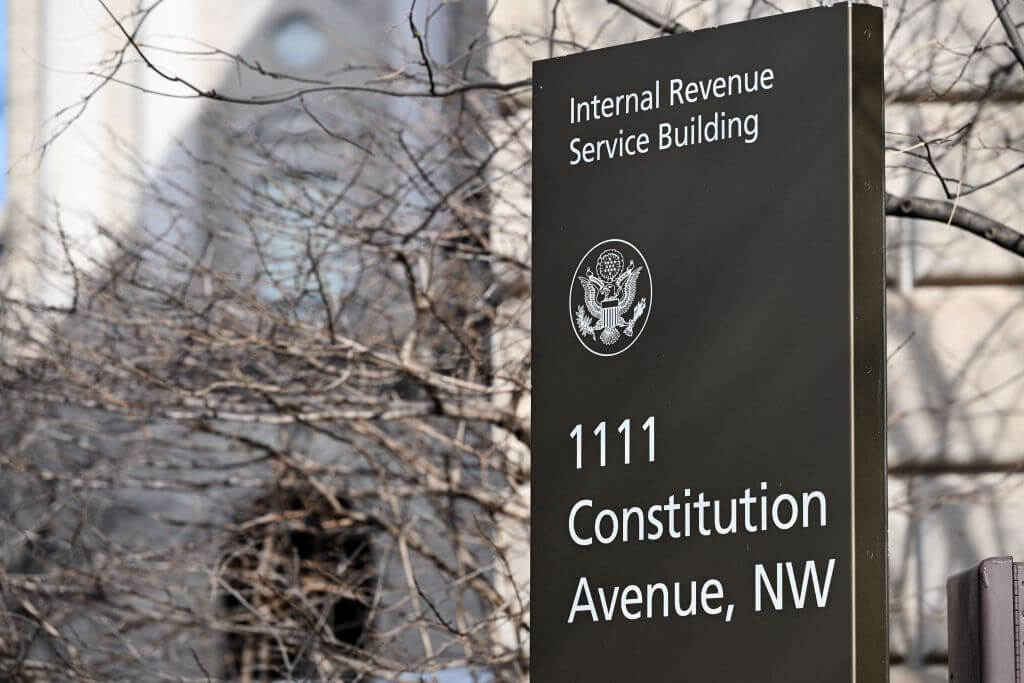Which COVID-19 Safety Policies Will Comfort Consumers?

As more states relax stay-at-home guidelines, many consumers across the country are re-entering spaces that were once very familiar to them: retail stores, restaurants and other public places.
While there are a number of safety measures consumer-facing businesses can implement to help curb the spread of coronavirus, brands and venues need to be mindful of which policies would make customers feel the safest until the outbreak is fully contained.
Morning Consult asked 2,200 U.S. adults which measures, including more hand sanitizer and limits on the number of customers in a store at a given time, would make them feel the most secure. They’re listed below, beginning with the action that would be most likely to make people feel safe.
Morning Consult also spoke with companies that are already using some of these tactics, along with business experts on which are the most cost-efficient. We also asked medical professionals to weigh in on which measures are the most effective in curbing the spread of COVID-19.
Implementing these measures will be trickier for some companies, many of which are already dealing with low sales and reduced staff.
”In general, it’s easier for bigger businesses to adapt,” said Tinglong Dai, an associate professor of operations management and business analytics at the Johns Hopkins Carey Business School.
While medical experts say the 10 policies can help prevent infections, they warn that no single measure will be enough to keep customers safe.
“You can't just hop on to one measure and think ‘If I do that and I do that one really well, I'll be fine,’ because there are plenty of points of failure in just one measure,” said Lucia Mullen, an analyst with Johns Hopkins Center for Health Security. “You want to be able to do as many as possible, as effectively as possible in order to reduce your overall risk.”
Click on a safety measure to jump to its section:
Regularly sanitizing high-touch surfaces — Installing more hand sanitizer dispensers — Spacing seating arrangements 6 feet apart to ensure social distancing — Allowing a smaller share of customers or attendees into certain spaces — Operating specific hours for the elderly, immunocompromised or vulnerable groups — Requiring all employees to wear masks — Posting signage encouraging social distancing among customers or attendees — Requiring all customers or attendees to wear masks — Offering prepackaged food or takeout in place of dine-in or served food options — Requiring temperature screenings for all customers or attendees
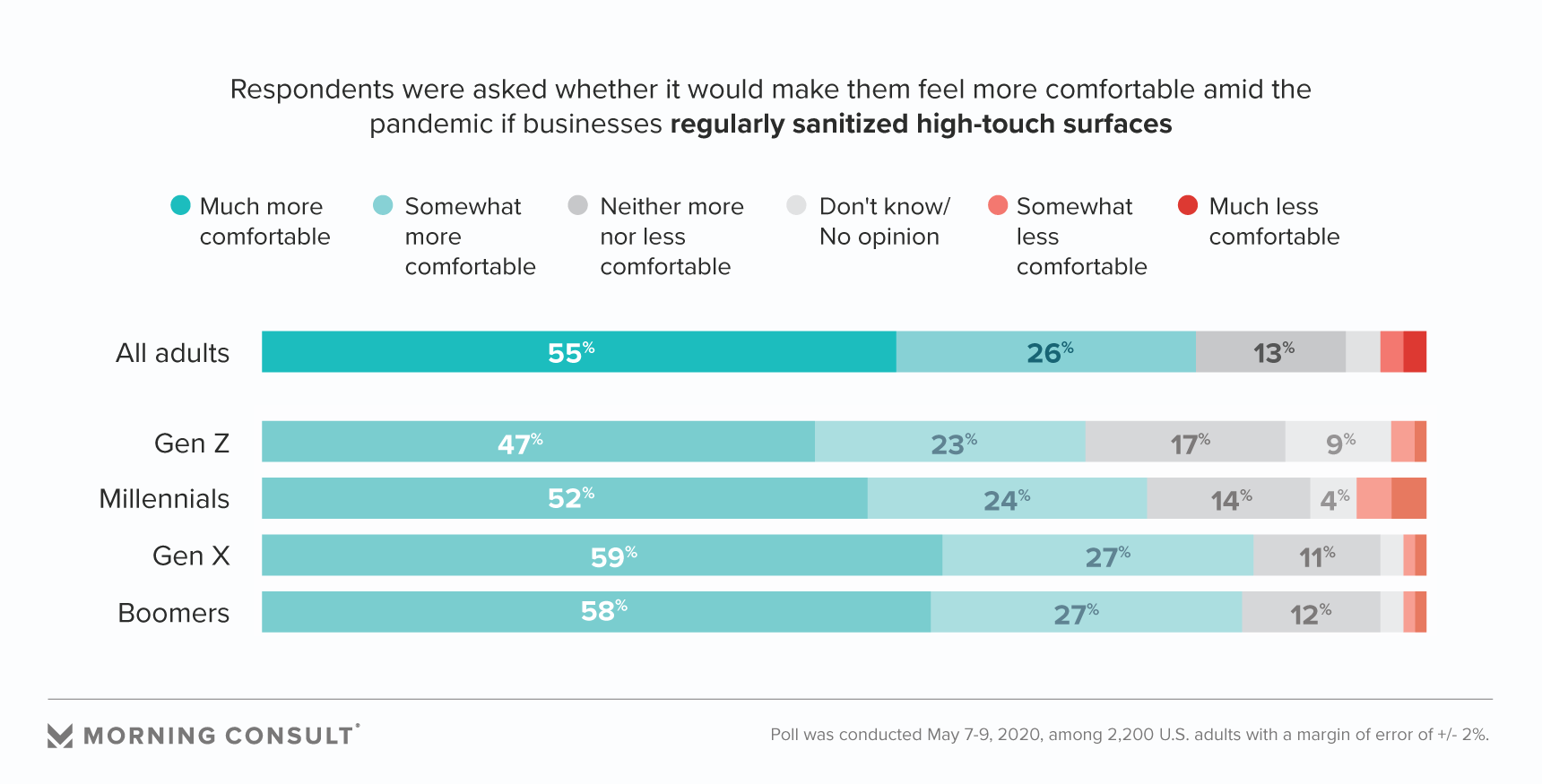
Medical experts said companies should focus on two types of ways the virus could spread: person-to-person and object-to-person. The most efficient thing that companies can do to make consumers feel safe deals with the latter: 81 percent of consumers said habitually cleaning high-traffic surfaces would make them feel more comfortable in businesses amid the coronavirus outbreak, including 55 percent who said it would make them feel “much more” comfortable.
Gyms face a unique challenge with this measure — sweaty customers sharing equipment, much of which they need to touch with their hands, doesn’t exactly scream hygiene — not only in convincing members that their space is safe but also in taking on the burden of elevated costs in cleaning all that equipment.
“Certainly there is going to be an impact to the operating costs of the gym,” said Chad Waetzig, executive vice president of marketing and branding for Crunch Fitness. He said he couldn’t put a figure on the full cost of cleaning until more locations reopen but predicts gyms across the country could be increasing their monthly dues to pay for the additional cleaning costs.
Part of carrying out this policy means more hands on deck. Julie Briggs Leone, proprietor of 443 Social Club & Lounge in Syracuse, N.Y., said staying on top of regular cleaning will be a big cost for her live music venue, estimating that she’ll add up to two extra people per shift just to clean.
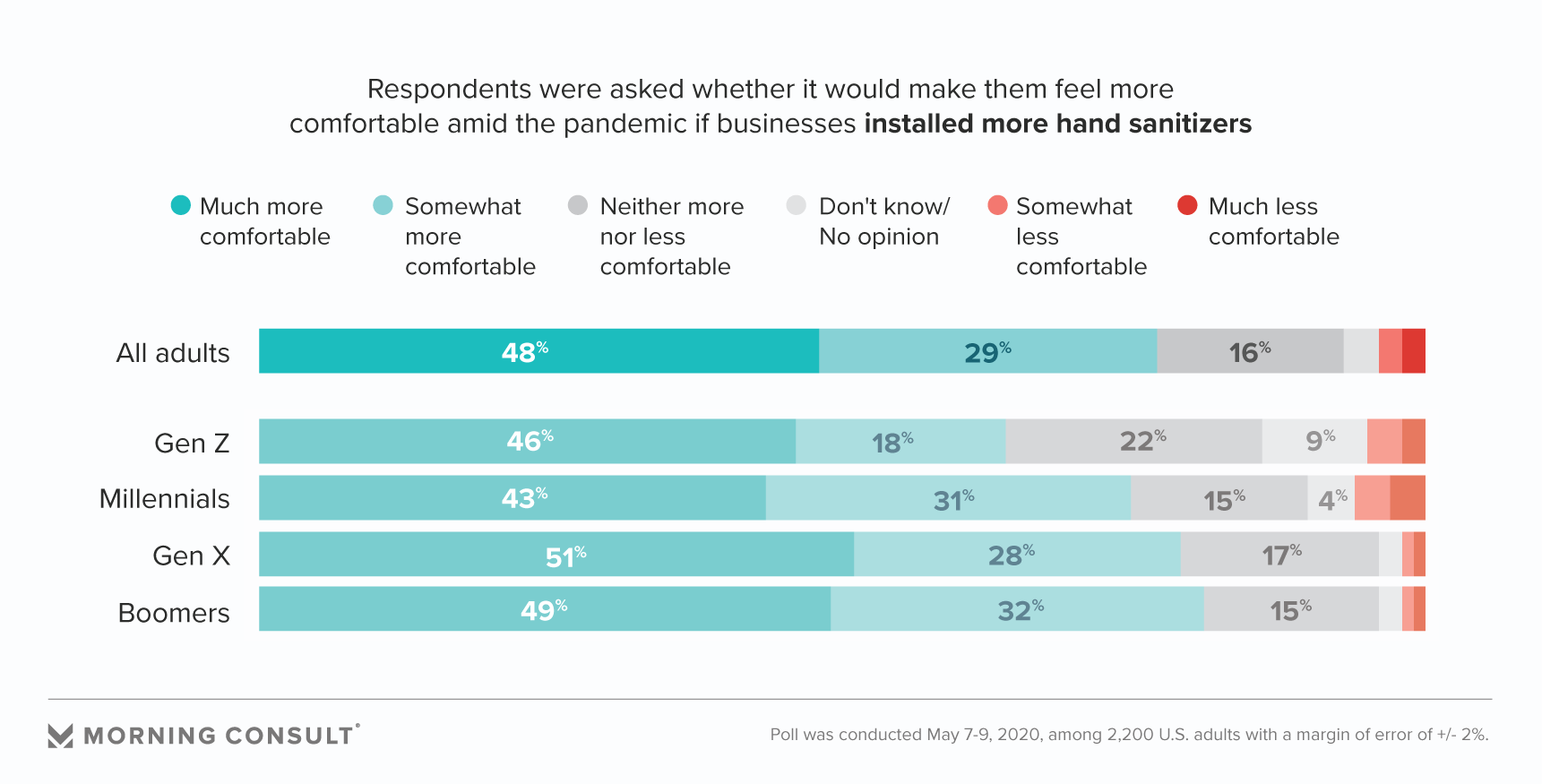
More than three-quarters (77 percent) of U.S. adults said making hand sanitizer more available in businesses would make them feel more comfortable.
Installing more hand sanitizers around businesses is “low-hanging fruit,” said Dai, of Carey Business School, adding that all consumer-facing businesses should already be implementing this low-cost policy.
Anthony Santella, an associate professor of public health at Hofstra University, said, “Hand sanitizer to me is a no-brainer, especially if you’re talking about a physical location that has bathrooms or high volume of traffic of people coming in and out.”
It’s a safety measure that has relatively low cost, too. Hand sanitizer stands retail for around $130 each and refills for under $50, but availability for both products could be limited. Wall dispensers are even cheaper, around $25.
This is a good first, but not final, step, said Dr. Kathleen Jordan, vice president and chief medical officer at CommonSpirit Health's Saint Francis Memorial Hospital in San Francisco. “Hand hygiene certainly supports decreased transmission,” she said. “It alone isn't going to prevent transmission.”
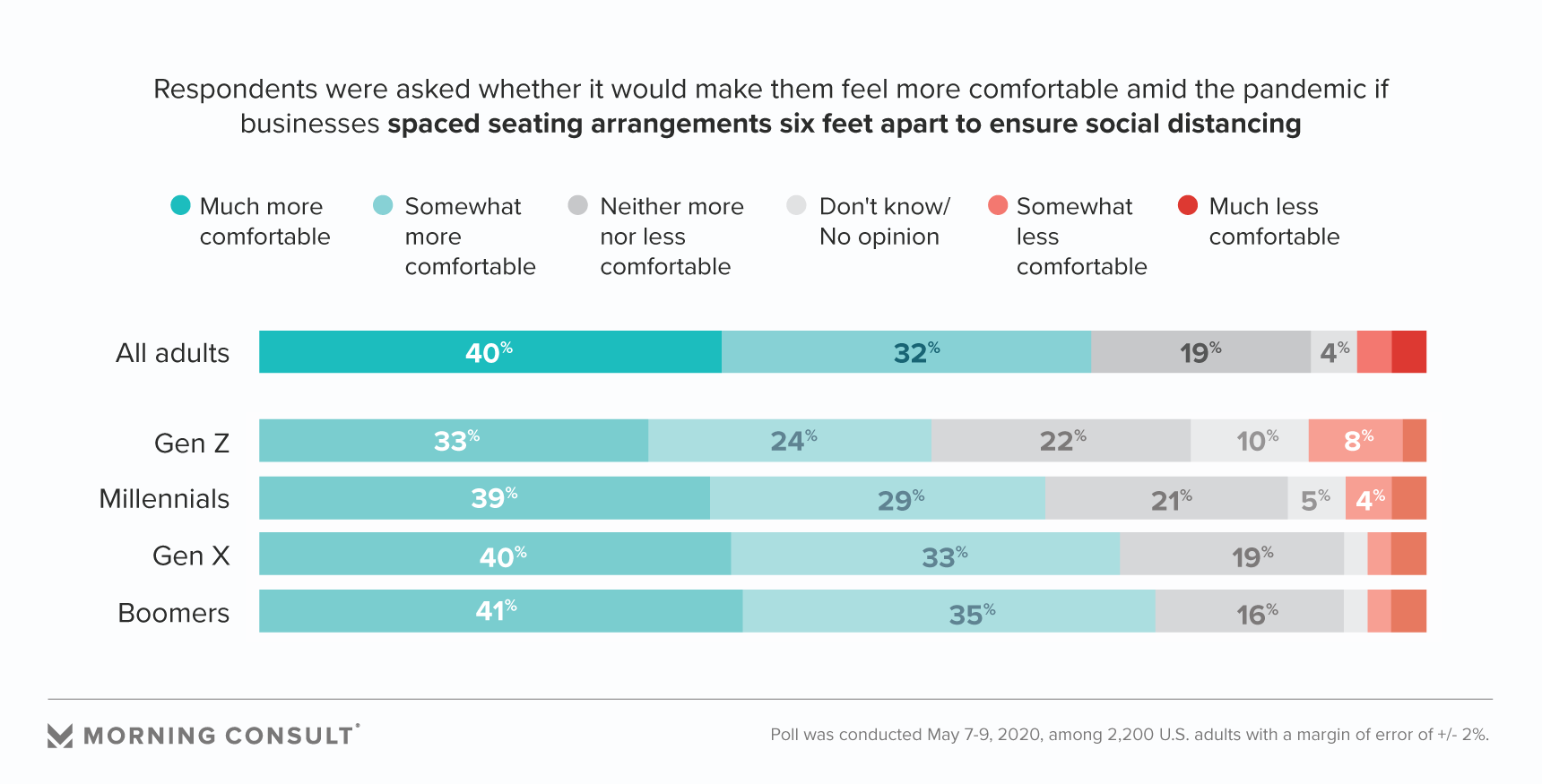
Social distancing is an important policy for spaces such as stadiums and movie theaters to be mindful of: 72 percent of consumers said they’d feel a greater sense of comfort if there was more physical space between their seat and that of others.
Many venues that have reopened are already taking steps to implement this measure. When three of Santikos Entertainment’s nine San Antonio movie theaters reopened on May 2, every other row of seats was closed off, with at least two seats empty in between each ticket holder, said Andrew Brooks, the company’s executive director of marketing and sales.
Audience members are dismissed row by row at the end of each film to avoid crowding. Brooks said each theater is running at 25 percent capacity, with sales reflecting that.
Gyms across the country are rearranging workout equipment, in some cases removing pieces to allow more space between.
Experts say this spacing out seats is a good tool, but, similar to the advice provided for other tactics, it must be used in conjunction with other safety features.
“You can't just be socially distanced while you're in your seat,” said Saint Francis Memorial Hospital’s Jordan. “You have to have a process and flow that also supports social distancing.”
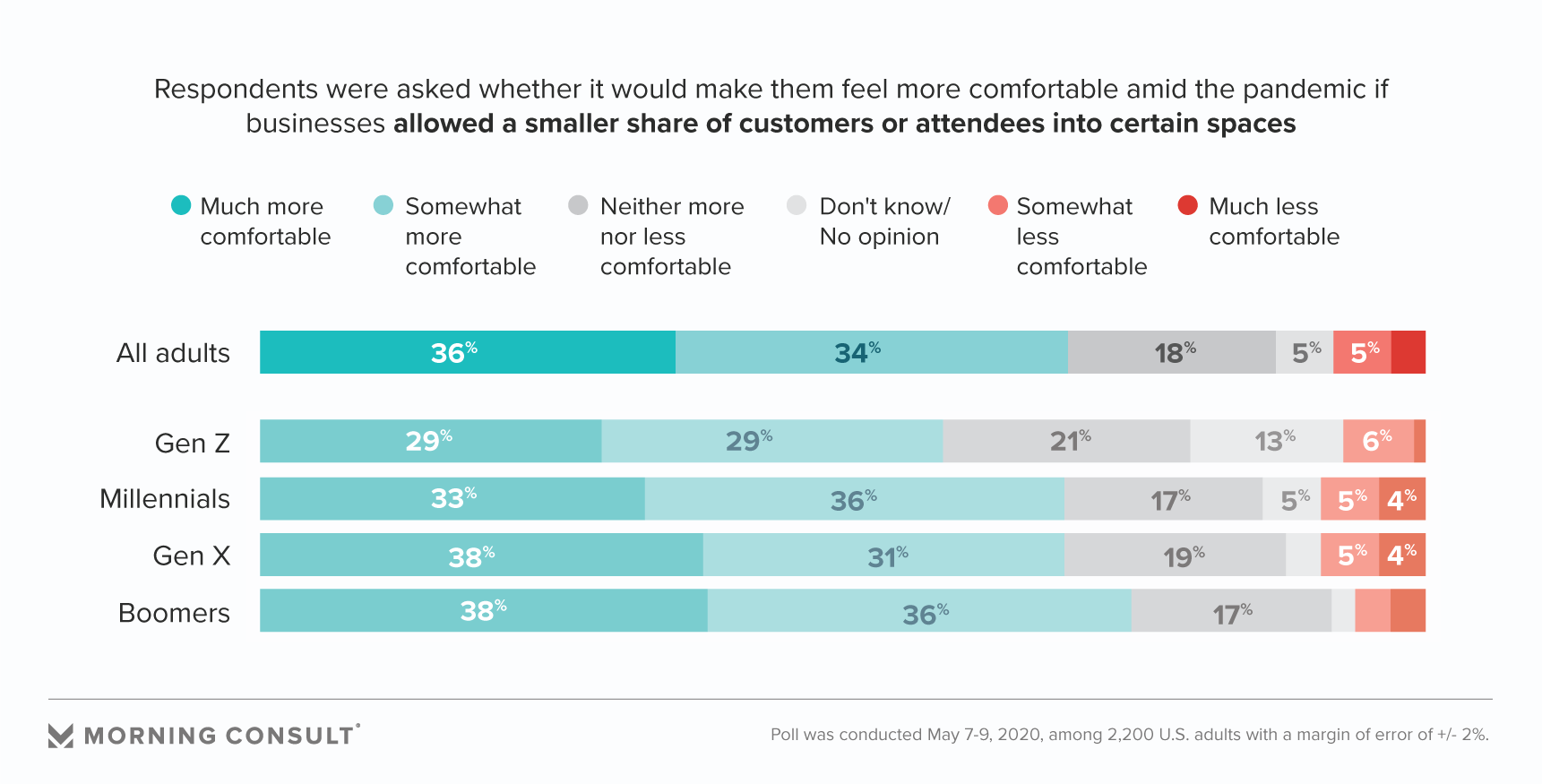
In addition to stepping up cleaning, stores, restaurants and other venues are going to have to face a harsh reality: Consumers might not feel safe in a crowded space. That means either less revenue, or creating a system where folks are there for shorter periods of time.
Similar to the share who said they’d feel safer if businesses physically space out patrons, 70 percent said they’d feel more comfortable if there were fewer people around as they shop or attend events.
Brands should think about their stores as systems, said Laurens Debo, a professor of business administration of Dartmouth College’s Tuck School of Business, and be mindful of three metrics, which are closely connected: how many customers can safely enter during a period of time, how long customers typically stay in your space and revenue.
At least one of these metrics will have to be adjusted when a store reopens, Debo said. For instance, if a business hopes to keep its revenue steady and does not want to limit the number of customers allowed in at once, it would have to decrease the amount of time each customer spends shopping. This could hit some retailers, as browsing leads to sales.
“You want to convert as quickly as possible and get people out of the stores,” said Robert Shumsky, a professor of operations management at the Tuck School of Business. “The smartest retailers will be the ones who manage this trade-off in a way that doesn’t impact, or maybe even heightens, the customer experience.”
Music venues and other gathering places also face a unique challenge, as they are “all about getting the bodies in the door,” said 443 Social Club & Lounge’s Leone.
Cameron Smith, senior vice president of entertainment at HUB International, where he focuses on concerts, said, “Each music or entertainment venue is going to have a break-even capacity point where it just doesn’t make sense to open if they can’t get above it.” That number will differ for each venue, or even each show, based on factors such as artist deal structure, concessions and other revenue streams.
“For some events, a venue may break even at 60 percent capacity with attendance above that being profit, and other shows might need 80 percent capacity to make money,” he said. In those cases, ticket prices will have to increase to make up the difference.
443 Social Club & Lounge, which holds 90 people, said it plans to operate under a 50 percent capacity and will likely be one of the last spaces to reopen in Syracuse. The soft furniture is gone since it’s more difficult to sanitize, and it has spent about $1,000 on new tables and chairs.
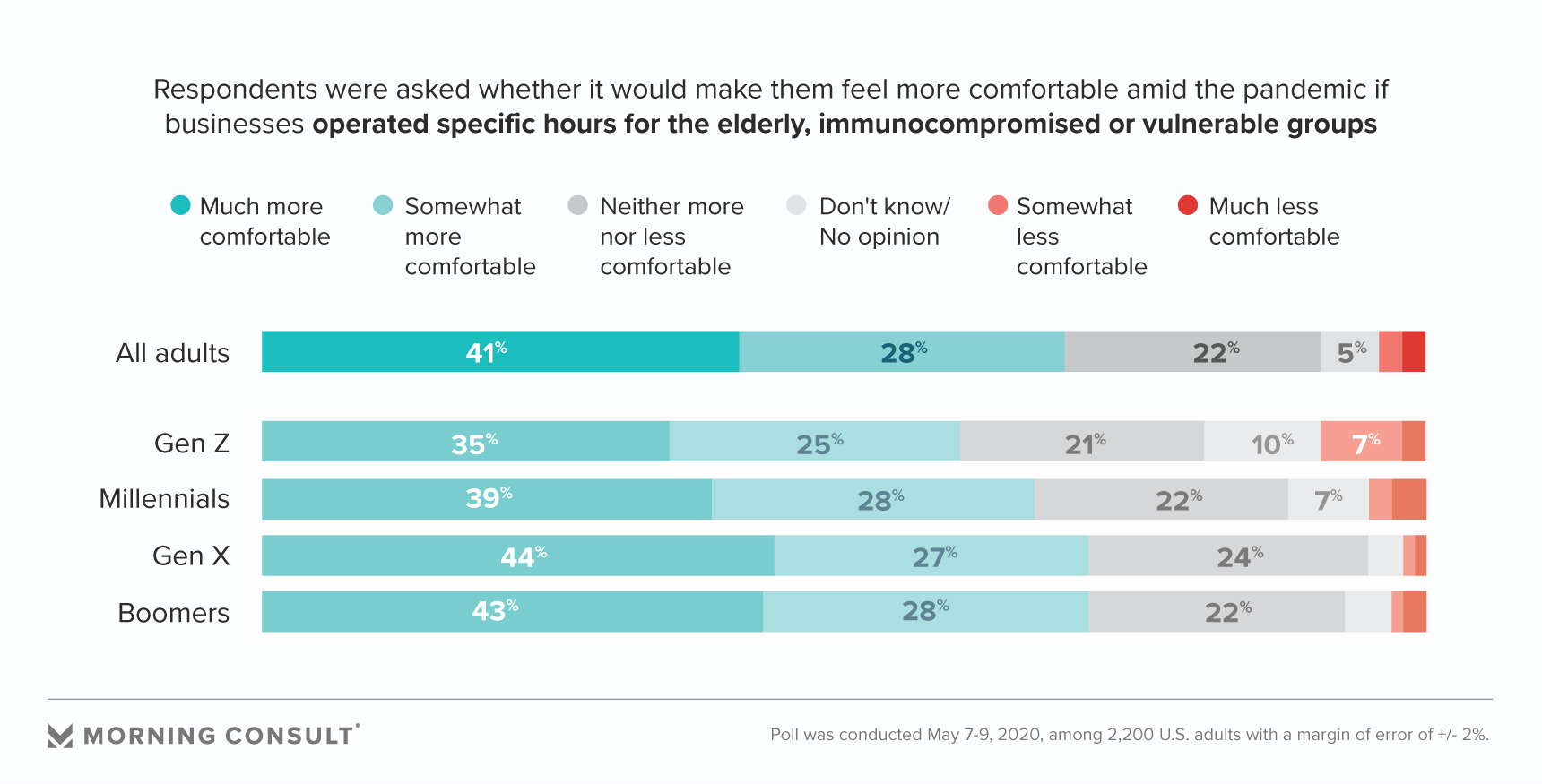
“Any large group gathering is going to offer a potential for transmission,” said Jordan, of Saint Francis Memorial Hospital. “So if you have a large group gathering of an at-risk group, you still have potential for transmission.”
Nearly 7 in 10 (69 percent) U.S. adults, including 71 percent of baby boomers, said holding business hours just for vulnerable groups, such as the elderly or immunocompromised, to patronize would make them feel safer.
One solution for some businesses is to adopt an appointment-based schedule, minimizing customer-to-customer interaction. Consumers would visit businesses at more evenly spaced intervals, reducing the possibility of waiting in large crowds.
Dai, of the Carey Business School, said if done successfully, companies don’t necessarily have to sacrifice volume.
“If you can reduce your variability by imposing these appointment rules, then you can handle larger capacity given the same operational constraints,” he said. “Businesses do not have to suffer.”

Sixty-nine percent of respondents said stepping into a business in which employees are wearing masks would make them feel more at ease.
“The mask isn’t to protect you, the wearer,” said Dr. Tista Ghosh, senior medical director and epidemiologist for the California-based healthcare company Grand Rounds. “It’s to protect others around you if you’re asymptomatic.”
Ghosh advises employees wear masks because they’re potentially coming into close contact with more individuals than the average consumer.
Although accessibility to non-medical grade masks is getting better, experts said there is still an ongoing shortage. That shortage causes prices to fluctuate, making it much harder to estimate the cost to supply all employees with face masks.
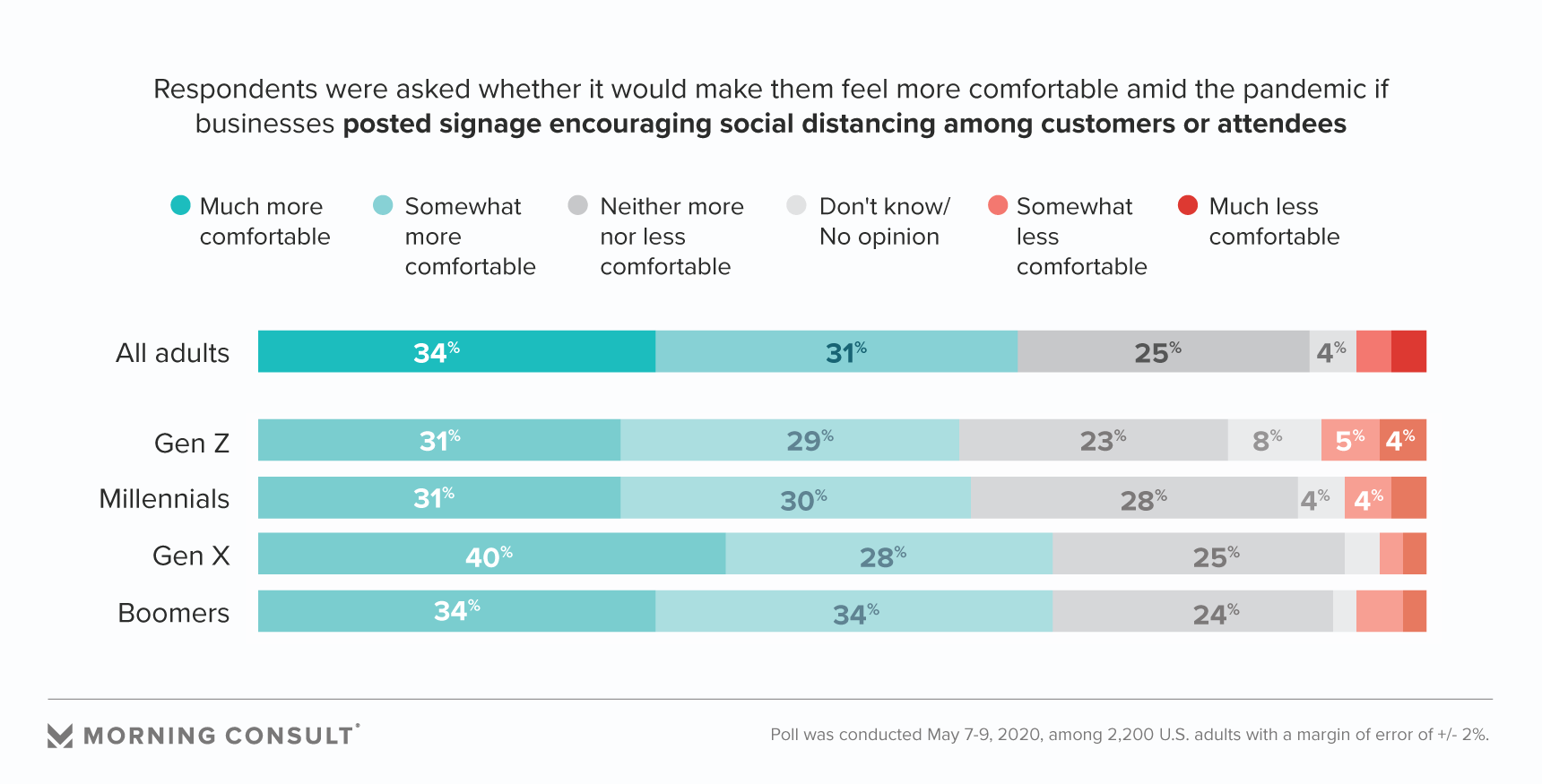
Signs encouraging customers to stay 6 feet apart were among some of the first safety features popping up in grocery stores across the country. Although this measure is fairly far down on this list, most people (65 percent) would feel more comfortable if businesses enacted this inexpensive tactic.
“It’s a low-cost thing that might go a long way — at least as a reminder,” said Hofstra University’s Santella.
That said, one-quarter of respondents said it wouldn’t make a difference one way or another.
But business professionals warn that asking patrons to stay 6 feet apart will be costly for many small businesses, especially those dealing with physically small storefronts: Fewer customers in a small space means fewer opportunities for sales.
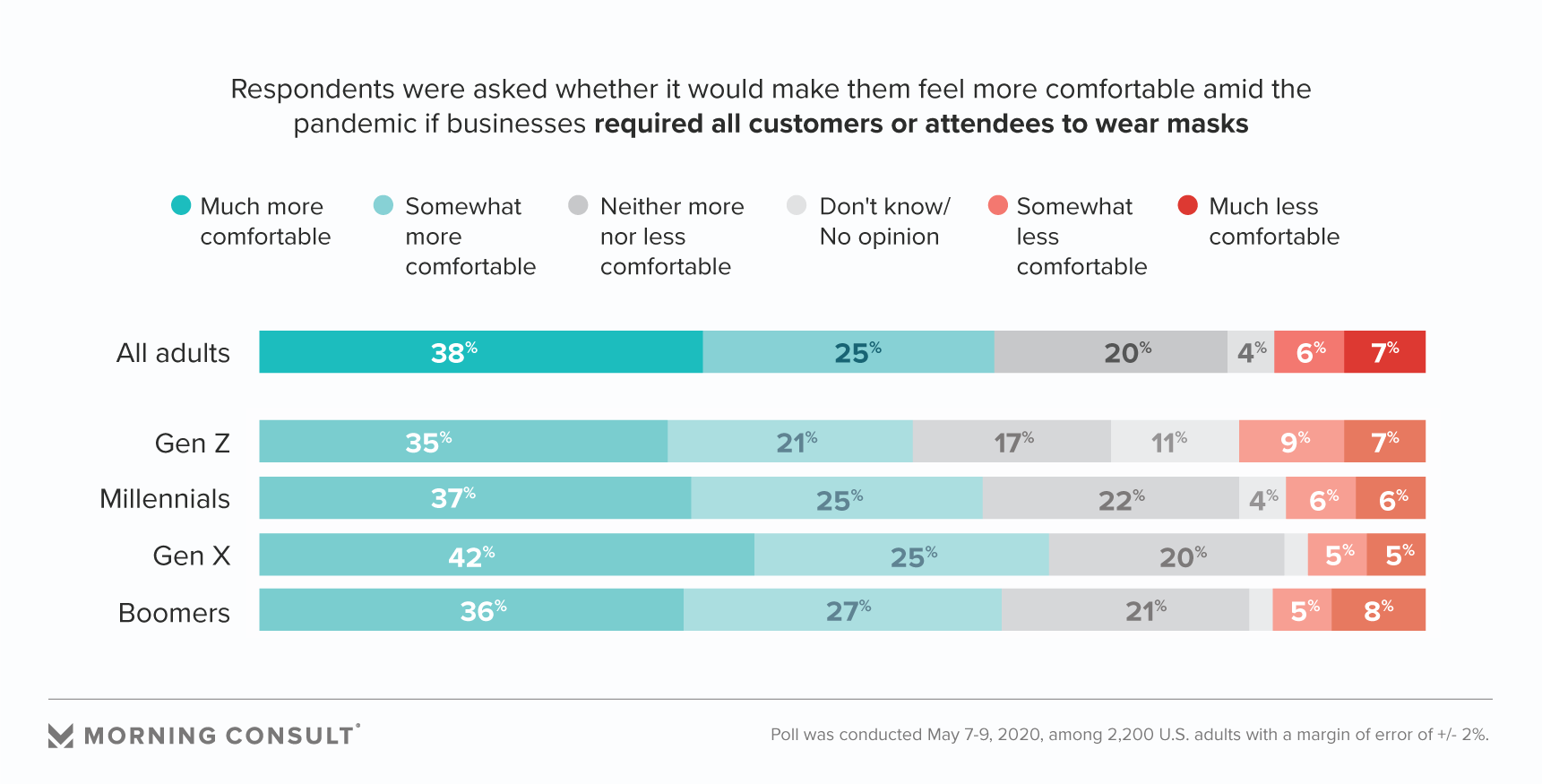
Respondents said they’d feel slightly less comfortable being required to wear masks into businesses (63 percent) than if employees were mandated to wear them (69 percent). In fact, 13 percent said they would feel less safe if they were required to wear a face covering.
Although the Centers for Disease Control and Prevention recommends wearing face coverings, it may not be enforceable in all areas. But several companies such as Costco Wholesale Corp. and Lyft Inc. are requiring staff and customers to wear masks if they wish to patronize them.
Businesses might need to educate customers on how to properly wear masks, however, and the practicality of strict adherence to a mask policy could depend on the venue.
“For a sporting event, you can be there for several hours, so people around you will be removing their masks to eat,” said Jordan, of Saint Francis Memorial Hospital. “Masking alone is not going to be the sole measure and solution, but it can be done as one of the many tools that you employ to decrease transmission.”
Requiring face masks could also offer an opportunity for some businesses to offset other safety-related costs: Crunch Fitness, for example, is looking into selling branded face masks and branded workout gloves.
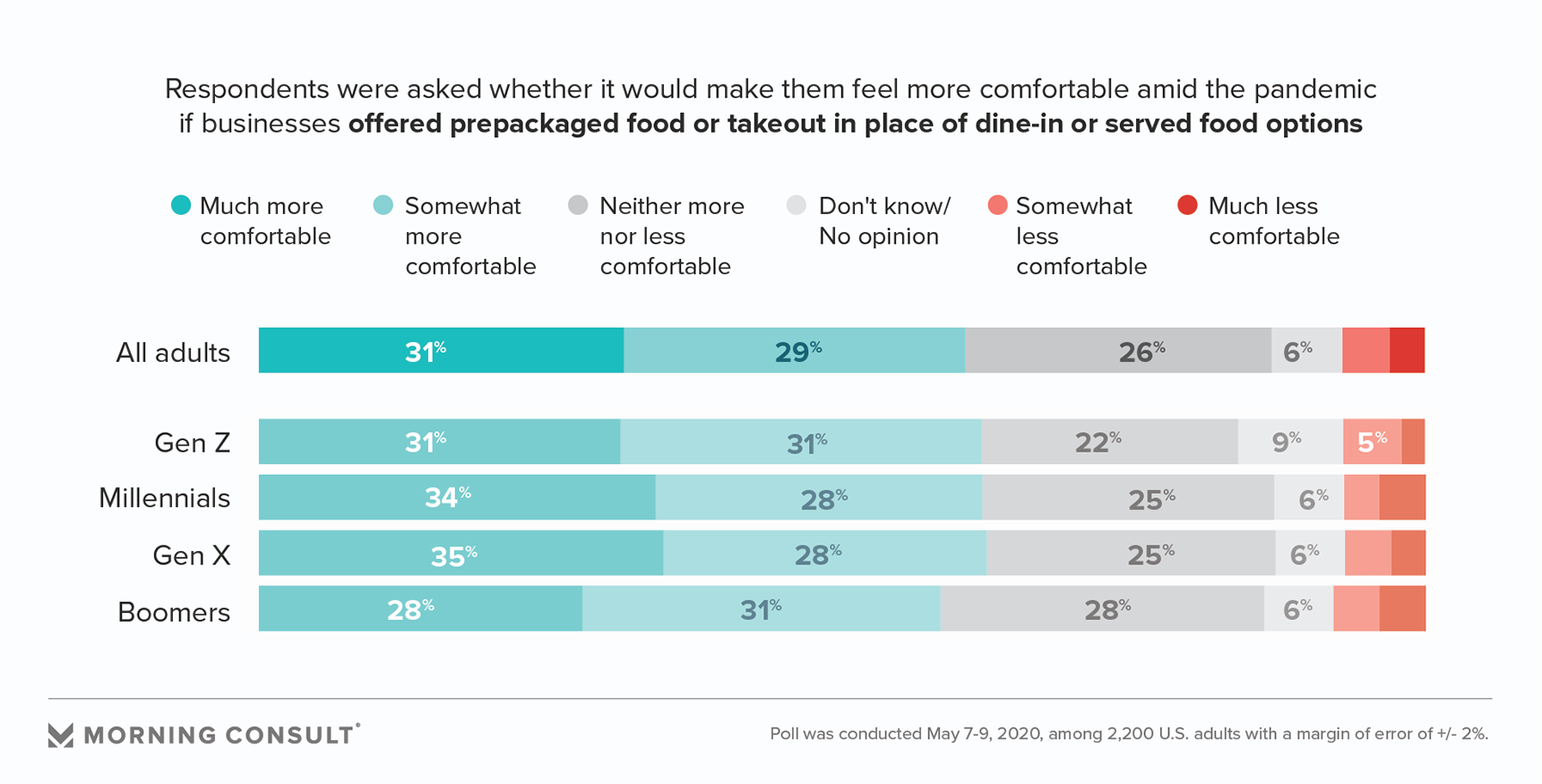
Extra steps will be required for businesses looking to serve food post-pandemic, including exploring touchless food delivery options. Three in 5 said they would feel safer if businesses offered prepackaged food in place of served options.
“Normal concessions, you belly up to a bar, and you wait in a line,” said Jack Hogan, director of strategic partnerships at the technology company Mashgin Inc., which manufactures touchless self-checkout systems. “That's something that we're obviously trying to avoid — stagnant people breathing on each other, standing 2 inches from each other.”
Using Mashgin’s technology, concessionaire Aramark developed a grab-and-go beverage distribution concept called “Walk Thru Bru,” in which customers walk single file through an area lined with beer, grab one at the end and check out. Aramark said this has helped speed up transaction times by up to 40 percent, which leads to less congestion among patrons in addition to eliminating cashier-patron contact.
Kevin Anderson, chief strategy officer at the software company Appetize Technologies Inc., which provides point-of-sale systems and mobile ordering in roughly 60 percent of top-tier U.S. sports venues, forecasts consumer food habits will evolve into a combination of online pre-ordering, mobile in-seat ordering or using near-field communication technology at the point of sale to limit touching.
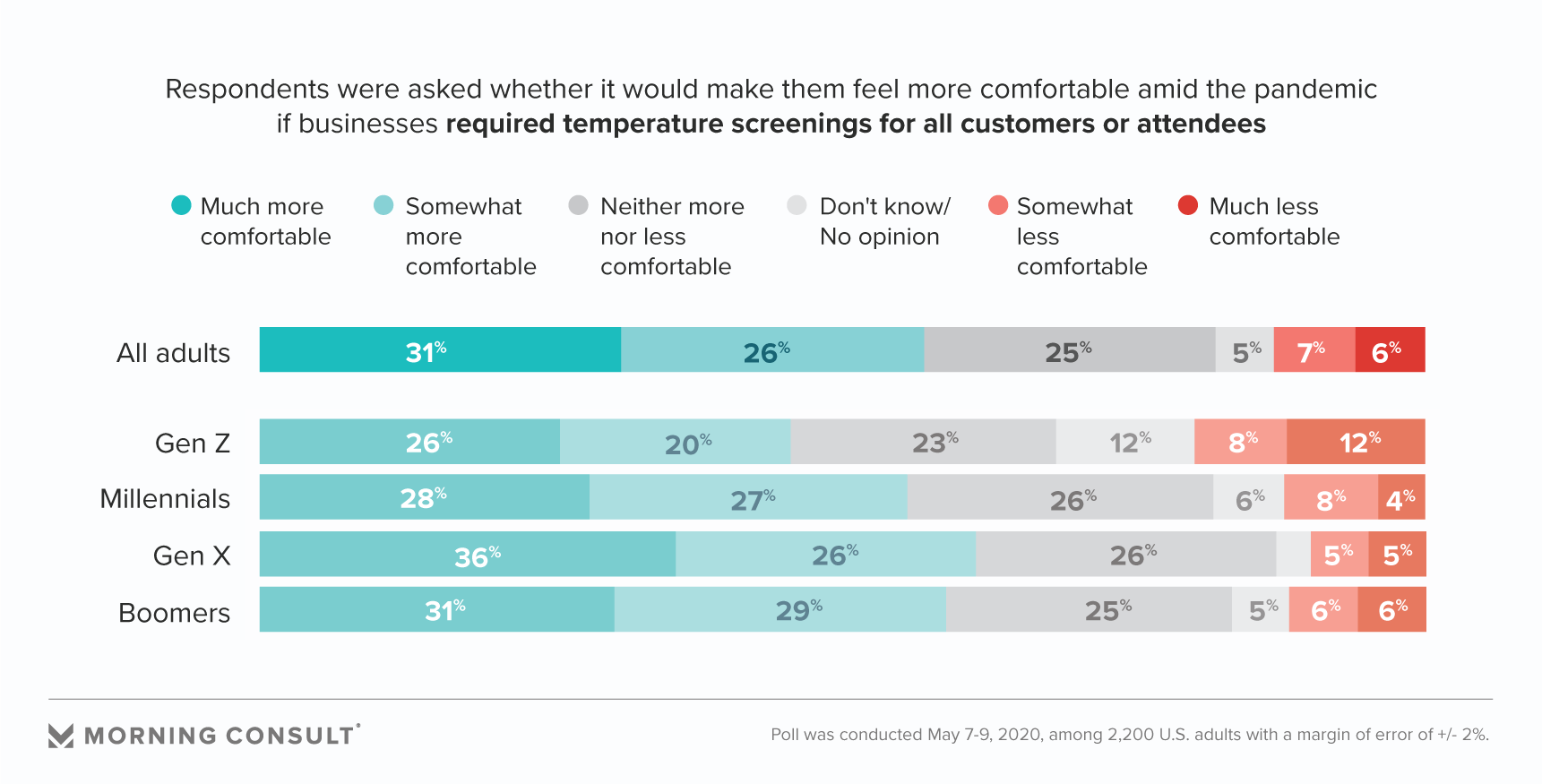
Perhaps the most labor-intensive measure and, in some cases the most expensive and intrusive measure, is mandatory temperature checks of attendees and patrons. It also garnered the smallest share of respondents saying they would be comfortable with this tactic, and 13 percent of respondents said it would make them feel less safe.
Emerging technology — including thermal imagers, thermal cameras and temperature guns — has made this approach more accessible, if brands’ wallets can stretch that much.
Kyle Hopkins of 911 Security, an airspace security software and solutions provider, priced individual thermal imaging units between $2,000 and $40,000 apiece, adding that you pay for what you get in terms of accuracy.
Lower-tech options are available. Infrared no-touch thermometers range from $100 to $175, according to a representative with AOSS Medical Supply Inc., which sells its own product to businesses and direct to consumers for $119.
Medical experts applaud the technology but warn that it identifies only those who are symptomatic and won't alert businesses to pre-symptomatic or asymptomatic individuals.
Jordan, of Saint Francis Memorial Hospital, said announcing the presence of the thermal guns adds another layer of protection: deterring people from coming if they feel sick.
“Ultimately, we need ill persons to stay home; they need to be responsible and stay at home,” she said. ”Thermal scanners can support that.”
Correction: An earlier version of this story misstated the share of respondents who said they'd feel more comfortable if employees were wearing masks.
Sarah Shevenock previously worked at Morning Consult as a reporter covering the business of entertainment.
Alex Silverman previously worked at Morning Consult as a reporter covering the business of sports.
Alyssa Meyers previously worked at Morning Consult as a reporter covering brands and marketing.
Related content

As Yoon Visits White House, Public Opinion Headwinds Are Swirling at Home
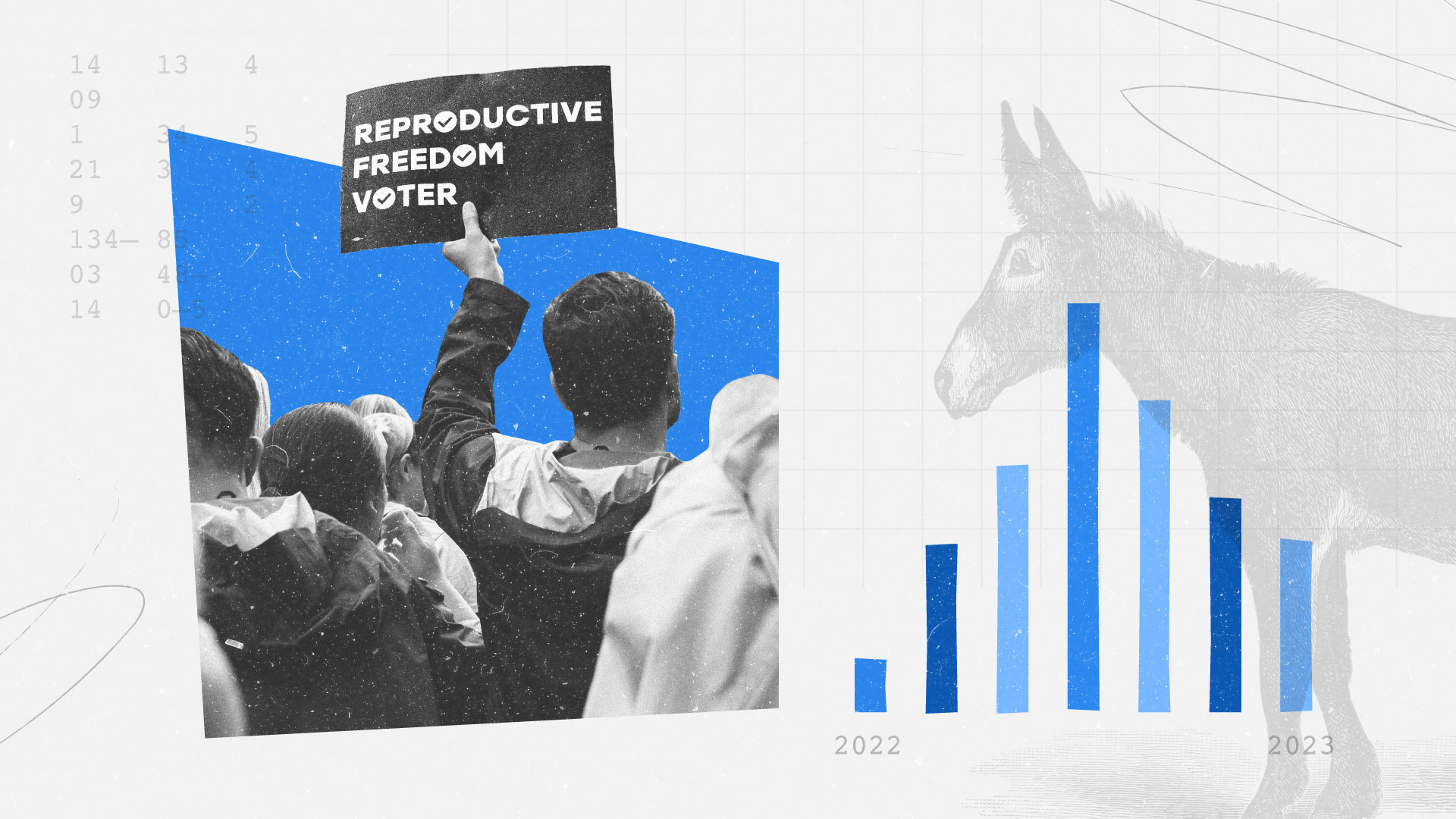
The Salience of Abortion Rights, Which Helped Democrats Mightily in 2022, Has Started to Fade
